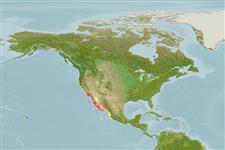Preferred temperature (Ref.
123201): 19.4 - 26, mean 22.3 °C (based on 16 cells).
Phylogenetic diversity index (Ref.
82804): PD
50 = 0.5020 [Uniqueness, from 0.5 = low to 2.0 = high].
Bayesian length-weight: a=0.01148 (0.00470 - 0.02806), b=3.05 (2.88 - 3.22), in cm total length, based on LWR estimates for this Genus-body shape (Ref.
93245).
Nivel trófico (Ref.
69278): 3.5 ±0.54 se; based on food items.
Resiliencia (Ref.
120179): Medio, población duplicada en un tiempo mínimo de 1.4-4.4 años (tm=3.5; tmax=31).
Fishing Vulnerability (Ref.
59153): Moderate to high vulnerability (47 of 100).
Nutrients (Ref.
124155): Calcium = 16.9 [9.5, 39.4] mg/100g; Iron = 0.475 [0.247, 0.822] mg/100g; Protein = 19.1 [17.3, 20.8] %; Omega3 = 0.226 [0.136, 0.382] g/100g; Selenium = 22.5 [11.7, 41.9] μg/100g; VitaminA = 43 [14, 145] μg/100g; Zinc = 0.675 [0.452, 1.012] mg/100g (wet weight);
